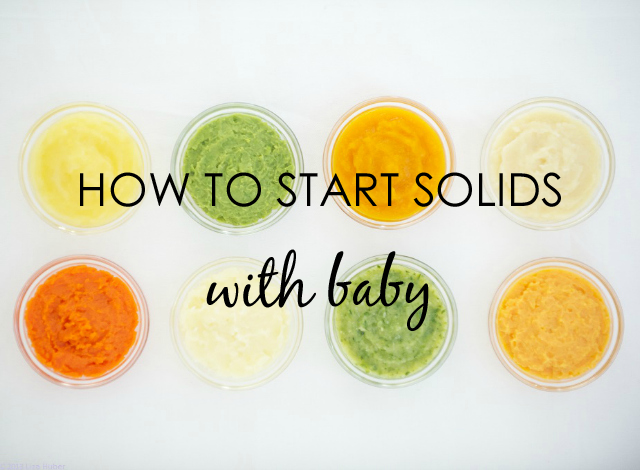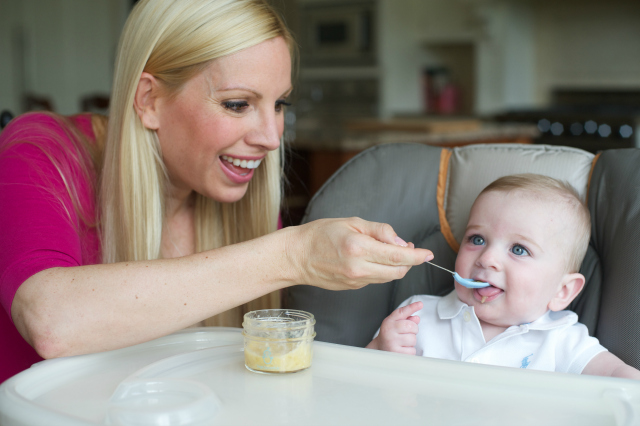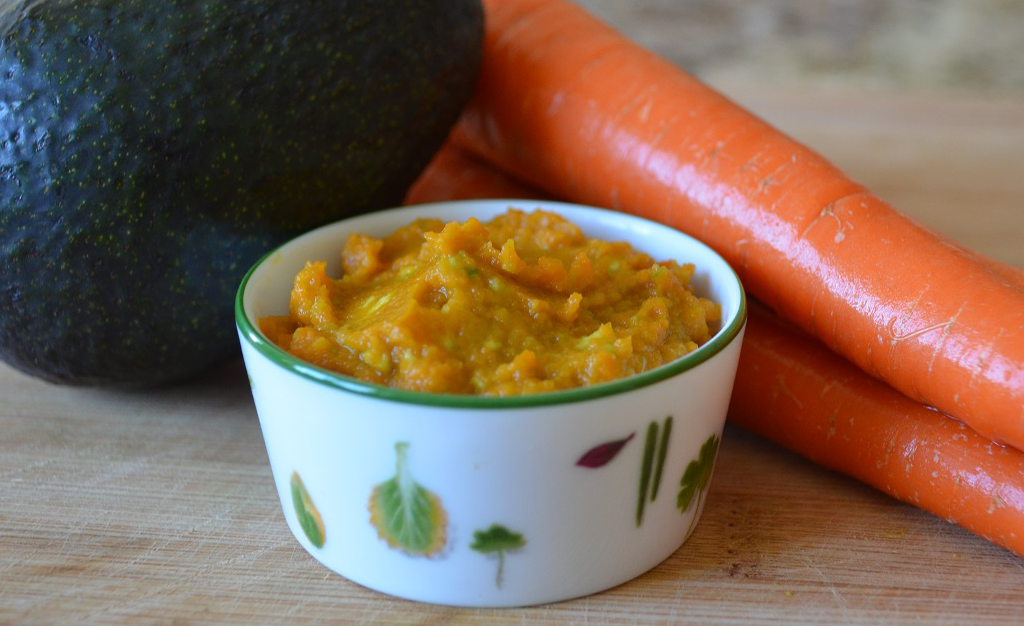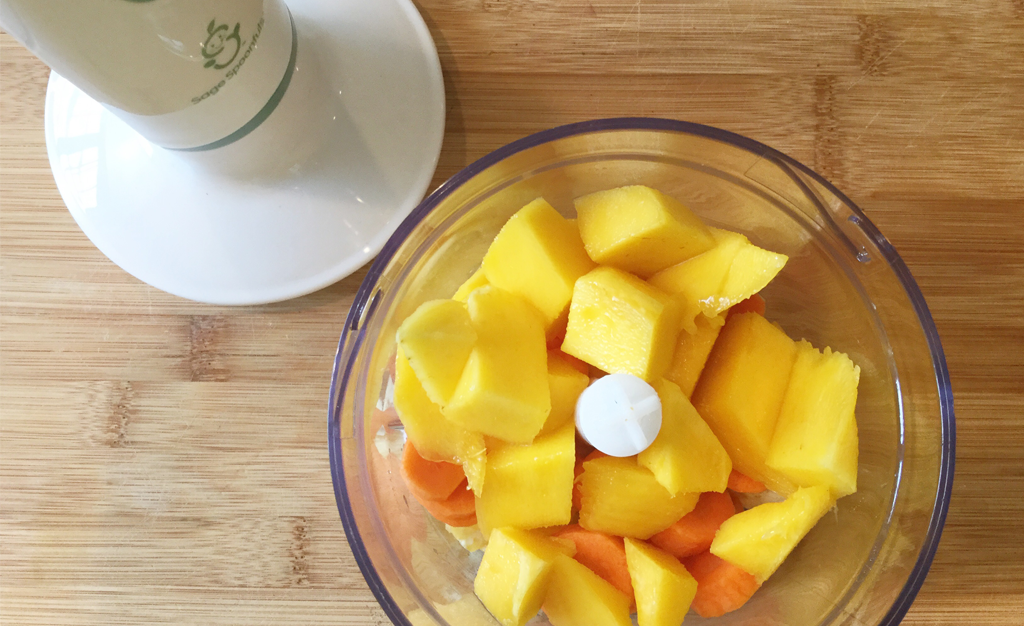We’re happy to welcome Liza Huber as the newest member of our team of expert contributors. Liza, of Sage Spoonfuls, is a homemade baby food connoisseur and advocate for healthy living.
Starting your baby on solid food is a fun and exciting time for both you and your little one. You are not only teaching your baby how to swallow food from a spoon, but you are also helping her develop a love of mealtime. While this is an exciting time, you may also have a lot of questions and some anxiety about this new venture, especially if it’s your first baby. Feeling this way is completely normal, but don’t worry, by following some simple steps and the advice of your pediatrician, you can’t go wrong.

When Is My Baby Ready For Solids?
Most babies are ready to start on solids between four to six months old, but every baby is different so please check with your pediatrician to determine your baby’s readiness. Personally, I started each of my four children on solids at five months old. Signs that your baby may be ready are: baby can sit up with support, baby can hold her head up and has control of her neck, baby shows interest in and possibly reaches for the food you are eating, baby has doubled his birth weight, baby is still hungry after a bottle feed.
What are the best first foods for my baby?
The best first foods for your baby are easy-to-digest, non-allergenic fruits and vegetables like banana, peas, pear, butternut squash, avocado, apple and sweet potato. You absolutely do not need to start with rice cereal. My son Royce started with carrots, my son Brendan with banana, my daughter Hayden with apple and my son Mason with butternut squash. It has been my experience that it really doesn’t matter if you introduce a fruit first or a vegetable first. Babies will eat what tastes good to them. I recommend alternating between fruits and vegetables. For example, if you gave your baby peas as his first food, try apples next.

What texture should the puree be for this stage?
The texture should be smooth and creamy—no lumps or anything that would be difficult for your baby to swallow. If you need to thin the puree, add a little water, breast milk or formula. If you need to thicken it, add a little baby cereal.
When is the best time of day to give my baby a solid meal?
A great time to give your baby a solid meal is in the late morning after a nap because she will be rested and ready for some yummy puree! Let her drink some of her bottle or nurse for a few minutes before offering your puree. That way she will have satisfied a little of her hunger but won’t be completely full yet. Try to feed her in the same place around the same time, and start a routine—babies love having a routine.
How much do I feed my baby at this stage?
In the beginning, there is no need to worry about how much solid food your baby is eating. Right now, the idea is to get him used to swallowing food from a spoon and excited about mealtime. For that first meal, start with a teaspoon or two of puree, and be sure to demonstrate swallowing from a spoon so your baby can see what he is supposed to do. As your baby learns, those teaspoons will turn into tablespoons and then into ounces! When introducing new foods, give the same food for three days straight, so if there is any kind of reaction, you will know what caused it.

Consult with your pediatrician on a good food schedule for your baby, but I like to offer a solid meal once a day for about 2-4 weeks; then, if your baby is ready, you can bump it to two solid meals per day. The rest of your baby’s feedings will remain the same—either breast milk or formula. The size of the solid meal will depend on your baby. He may only take a few bites or he may devour the whole thing and want more. Keep in mind that it’s not about “cleaning your plate.” It’s about enjoying the new experience of eating food. Follow your baby’s cues. He is finished when he turns his head away, starts spitting the food out or swats at the spoon. Just like us, sometimes babies are really hungry, and sometimes they aren’t.
What if my baby doesn’t seem to like the food and keeps spitting it out?
Don’t stress if your baby spits the food out in the beginning; in fact, it is a natural reflex. Some babies take to swallowing solid food right away, and others take a few days or even weeks to get the hang of it. If your baby is consistently thrusting his tongue out when you try to feed him, wait a few days or a week, and then try again. Royce took a week to get used to the idea of swallowing food, Hayden five days and Mason two weeks, but Brendan took to it on the first bite, and he was a preemie!
Homemade Baby Food vs. Store Bought
Lots of parents ask me what the difference is between homemade baby food and store bought. Store bought baby food is processed, so it can have a long shelf life, and homemade is fresh. Homemade is healthier than store bought and up to five times less expensive! Homemade baby food is also a lot easier and far less time consuming than many parents may realize. With Sage Spoonfuls, you can make two weeks of baby food in as little as ten minutes and store it in the freezer. That way, you have the convenience of store bought but with all the amazing benefits of homemade.
I’m looking forward to sharing lots of yummy and easy baby food recipes with you in future posts!









Comments
J
This is very helpful information! How do you reheat the frozen baby food when you’re ready to use it?
Belma
Wow! They ask what is the difference between store and home made food ! Wow!!!! I guess baby formula and cereals and junk foods makes their IQs’ this level !!!!